![[Headline]](../../../technik/sonstige/headtran.gif)
![[Headline]](../../../technik/sonstige/headtran.gif)
The SPIEL Games Convention at Essen / Germany
The SPIEL 0619th to 22nd October 2006Tuesday, 17th of October3... 2... 1... Lights on, Camera ready, Micro open... 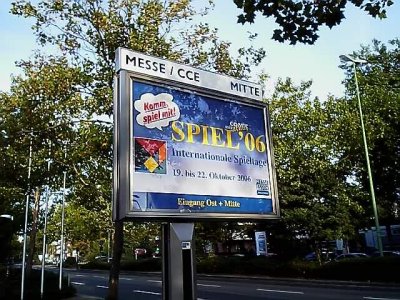 Folks, here is Essen / Germany ! And here we go again, welcome back everybody! Once again I am hopeful to entertain you with a bit of coverage from Essen, bringing those of you living on the far side of the world some of the unique flair and atmosphere which can only be felt at the world's biggest gaming Festival. Living now permanently at Essen, it will keep my reporting as easy as in previous years, and the shift could not have been bigger as the step which I took when I left my office this afternoon and headed for the convention area. This morning I was still discussing with my group of auditors which companies we would haunt the following months, and now I was once again heading for the anual gaming Mekka. Scanning through the lists of new games announced to be released at Essen, it sounds like we might have a quite entertaining convention ahead of us, with both the major publishers and the smaller privateer companies bringing a lot of really interesting news to us. As I have done the last year or two, my reporting will mostly focus on news comming from those smaller publishers, since Essen is the perfect place to learn about some more or less obscure games which would otherwise skip public attendance. However, some bigger news also have thrown their shadows ahead, and thinking for example of Battlelore from DAYS OF WONDER I am at least planning to cover some news of major publishers as well. We will see...  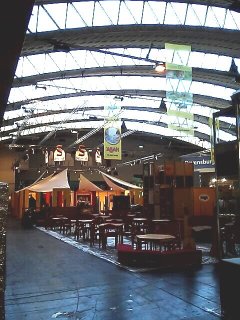 However, moving deeper into the halls and meeting up with some of the used games traders, I heard that today - the usual buildup day for all the smaller booths - there must have been quite an organisatorial delay due to the fact that the walls of quite a few booths were not standing when the first smaller exhibitors arrived in the morning.  During the course of the morning, the setback was finally resolved, but it resulted in some of the booths being prepared quite a bit later than usual and thus the delay was felt till closing time tonight. 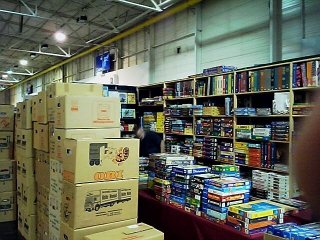 As indicated, this delay also did affect some of the used games traders, but what I could also observe was that seemingly the used games section has not shrunken in comparison to last year. There is still about a dozen booths appearing with the usual enourmous stacks of games, but while going through the titles available on their shelves I could also observe that the trend of more expensive games becoming absent at the SPIEL seems to be unbroken. Talking to the traders, they confirmed that the rare stuff is going to Ebay these days, and thus the used games section is getting less and less attractive for real collectors. Of course, the one or other gem still can be found at the convention, but I remember that years ago people from companies like FUNAGAIN GAMES had their freight forwarders carry home hundreds of used games. I cannot help the feeling that it will be much less games which might interest them this year. So, in the end, there seems to be not much of an alternative left to Ebay when you are looking for something really rare. Myself, I bought something today which most you you might not have imagined: I rummaged for 5-6 players expansions for Settlers of Catan and its expansions - all with wooden playing pieces. I never bothered to buy theseduring all those years when they were available; and as a matter of fact, I played my first 6-players game of Settlers just two weeks ago, and discovering the game for new I decided to look at Essen to get all expansions to be able to play my own game with six players as well... 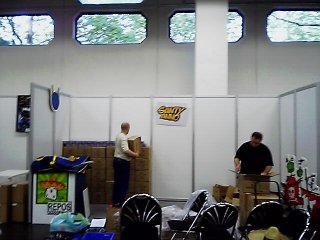 In the meanwhile, some other known faces have started to appear, and among them Cedrick Caumont of REPOS PRODUCTIONS has started to set up their convention booth for this year's SPIEL. Last year REPOS surprised the public with their action-packed, hillarious Ca$h n Gun$, and thus I will visit their booth on one of the following days to see whether their new cardgame Santy Anno is going to keep up with the high standard set by last year's game. 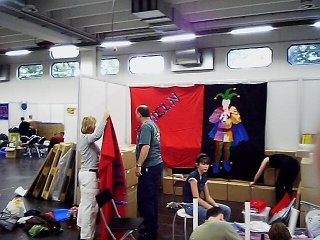 Talking about last year's convention hits, a few booths further I also paid a first visit to people of FRAGOR GAMES who were preparing their booth for the presentation of their new (already sold out!) game HAMELN. 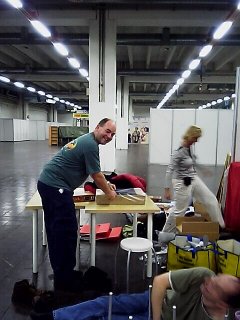 I actually found Gordon Lamont from FRAGOR at work (something rather unusual as his fellows would state - sorry Gordon... ;-) ), and he could spread hope for all of you who might not be able to secure a copy of Shear Panic last year: The rumors were true, a new edition of the game is released by the well-known german publisher ZOCH, and they have decided to give the game a first run of 7500 copies! Included are the famous sheep, and to keep the high standard they were actually produced by the same company which already did the sheep for the original game. But upon begging, Gordon also opened one of the splendid looking new gameboxes of HAMELN, and out came the blind passengers which had made the trip from Scotland to Essen: 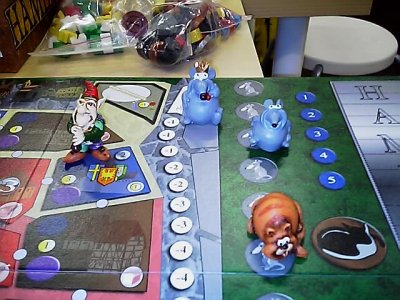 And as you can see, FRAGOR has kept the high quality of its playing pieces, and instead of sheep the buyers of HAMELN this time will get a bunch of Rats together with their King, a fat cat and a sly-looking Rat-Catcher. Stay tuned to the G@mebox, and I am sure you will get a chance to discover the closer meaning and the function of each of these cute playing figures on one of the following days... Wednesday, 18th of OctoberAnd here we go again, starting with the first "real" day of the convention… People seemed to have worked to deep into the night, since when I entered the convention halls this morning there were not major signs of yesterday's setback anymore, but all seemed to be in schedule 24 hours before public opening.   As it has been good practice these previous years, the convention traditionally starts with the Press Conference at 11 AM where the organisators offer a warm welcome to the hundreds of journalists which have found the way to the SPIEL. Once again, Mrs. Metzler from the FRIEDHELM MERZ VERLAG and Mr. Pohle from the FACHGRUPPE SPIEL were conducting the conference, and once again they started with the news that the SPIEL succeeded to break last year's records. This year, 730 exhibitors from 31 nations have made it here, and all in all the convention now covers an area of 10 halls (which comes up to 43.200 square meters). 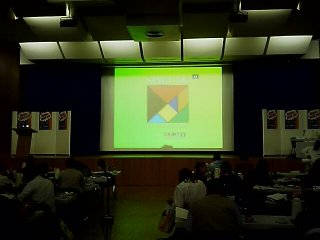 After the sheer numbers, Mrs. Metzler turned the topic to a study which had been conducted by the University of Leipzig on a research project together with RAVENSBURGER. In times of decline of the "traditional" family life and a daily strengthening of computer games, the University had made a study of the impact of boardgames on family life. Here the results strictly were as clear and positive as possible, with boardgames being in high esteem for strengthening contact and bonds between all generations of a family and furthermore having beneficial impacts on social life, cognitive performance and the reduction of egocentrism… Wow, that's quite a lot of special vocabulary to describe the facts that boardgames mean fun, communication and interaction, but it's great to hear that our hobby thus is sanctified as being up to date with the demands of modern life and social education…. Returning to the facts of the convention ahead of us, Mrs. Metzler pointed out that once again approximately 150.000 visitors would be expected at the SPIEL during the four convention days, and that they would find a total of over 350 new games at the convention. Numerous trends from previous years would be continuously present, so that educational games, classic family boardgames, quiz and cardgames, tabletop and fantasy games and collective card games all would find their space at Essen. However, some new trends and technologies also once again would be presented, and here Mrs. Metzler mentioned the new World of Warcraft Trading Card Game. The computer game now has found over 6.5 Million fans worldwide, and with the release of the new cardgame here in Essen for the first time a bride between online gaming and classic cardgames would be built. The new cardgame contains special cards which contain a code which can be entered in the online game, and once entered the players will receive special unique items which their online characters may use. Other news technologies feature a new version of an interactive gameboard from Public Solutions or a special ultraviolet printing technology which was used by SCHMIDT SPIELE. However, most of the games still rely on classic elements, so that these new kinds of boardgames still are a rather small minority. 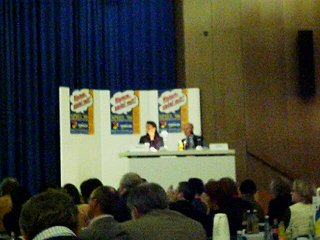 Coming closer to the conclusion of the press conference, you must remember that the SPIEL not only features boardgames but also the Comic Action, a convention of comic fans where they can trade and purchase rare comics, meet with designers or artists and have their own drawing skills evaluated or improved. 70 exhibitors have found their way to the comic action this year, and as Mrs. Metzler pointed the two areas of the convention would be interrelated even closer this year due to the fact that games like Stratego Marvel Heroes or Super Munchkin had taken up the topic of comic heroes. Finally, remembering that this already is the 24th annual SPIEL, we also turned to games history and went 20 years back when the first print of Obstgarten (HABA) and Das Verrückte Labyrinth (RAVENSBURGER) were released. Now both games celebrate their 20th anniversary with special editions, and following the publishers comments they still seem to be as attractive for buyers as they have been all those years back… 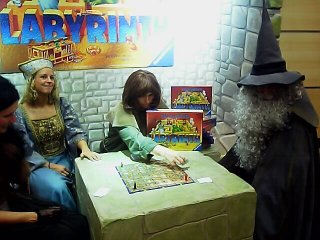 After the press conference the news show was opened, and here I was astonished to find so many attractive looking new games that I am honestly hard pressed to decide which games I should test and report on during the following days. 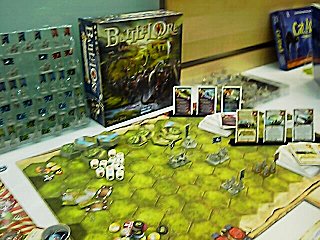 However, something good to see was the fact that some of the games which had been uncertain whether they would be ready for Essen or not actually were presented in the news show. Frontmost, I found the fabled new Battlelore, Richard Borg's newest creation following and enhancing his well known Command & Colours System. Over 200 beautifully crafted miniatures of Knights, Dwarves and Goblins are included, and together with the usual outstanding graphical design of DAYS OF WONDER the new game looked like it would promise long, exciting hours of gaming.   Another new game which was uncertain till the last second whether it would be available or not is Fürchterliche Feinde by Friedemann Friese. But this new dungeon-style-game, third and last game in the trilogy of "Fairy Fabula" after Fische, Fluppen, Frikadellen and Finstere Flure, has made it has well, together with all other games announced by 2F SPIELE.  This list of games can be continued if you wish with Haste Bock, the new ZOCH version of last year's Shear Panic by FRAGOR and some other titles, but the view of Haste Bock reminded me of a date I had to attend for the afternoon, and so I went over to the FRAGOR booth to visit the Lamont brothers who had invited me to join them at a pre-convention party which they were giving for a bunch of hobbyist gamers who had already arrived. 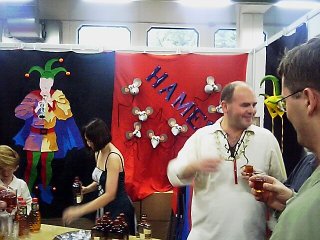 Getting to the booth, Gordon squeezed a glas of Scottish Mead into my right hand and some Stem Ginger Bread into the other... 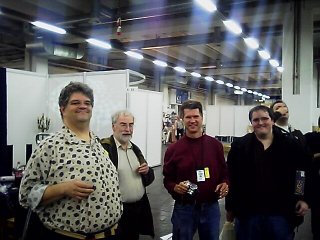 ... and there also were some of the usual Essen pilgrims like Greg, James and Ward from the USA or Stuart from Scotland. 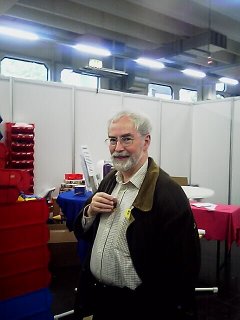 Having at least a few members of the International Gamers Awards team together, Stuart took the opportunity to give us some deeper insights into the origins of the Honey-based Mead-Spirits, and we all had to agree with him that - after it has been popular in the middle ages - it had been forgotten for too long a time. 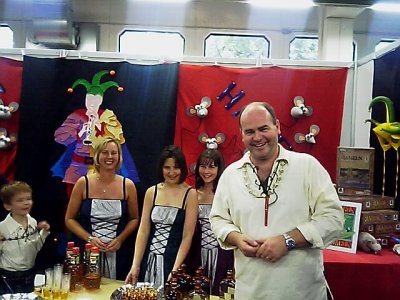 Later on, I left the party but not before thanking Gordon for getting such a nice "reunion" organised. The convention days are streeful enough, but this quiet interruption still in the preparation phase gave all of us some nice time to relax and talk a bit on the days to come. But the day was not over yet, and thus I finally went to the main convention building where the Dinner and Awards Ceremony of the Deutscher Spiele Preis takes place.   This year, both the awards for the best children's game and also the "Essener feder" for the game with the best rules went to Die Nachte der Magier by DREI MAGIER SPIELE. The game deservingly won due to its quite ingenious playing mechanism in a darkened room with luminiscent playing pieces, and also for its beautiful rules which were drawn like a children's book. 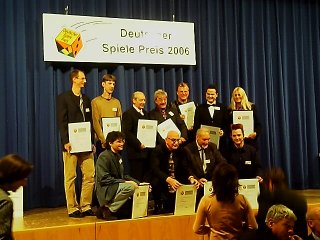 In the main category, the lower ranks were as follows:
 However, as we approached the top three it became visible that the new voting mechanism introduced for the Deutscher Spiele Preis by allowing "normal" gamers to vote via the Internet as well seem to be carrying first fruits, since with Antike by Walther M. Gerdts the third rank went to EGGERTSPIELE and thus a very small publisher which never before had even been in the top ten ranks of the Deutscher Spiele Preis.  Totally different then was the view on the second rank, since here Thurn und Taxis by Karen and Andreas Seyfarth had already received this year's "Spiel des Jahres" awards and also comes from HANS IM GLÜCK and thus a much better known publisher. 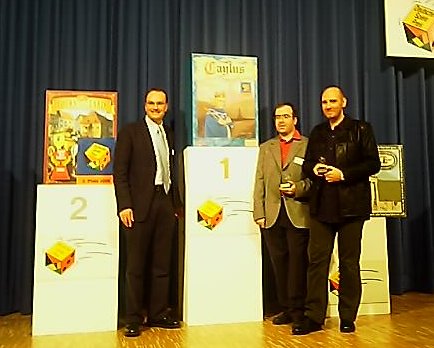 The winner, however, was the biggest surprise of the whole contest, since here the game Caylus by William Attia which had been published at Essen 2005 by the french publisher YSTARI GAMES had only be printed in a very low first edition of 5000 games and could not have been exepcted to march that victorious through the awards voting. However, for me it is a very positive sign since the new voting mechansim really seems to distinguish the games most liked by the public, and if you look at the attendance the game received at Essen last year it is more than justified that it now also got a fitting reward! Well, and here ends my first busy convention day. I guess I already need some sleep - it's late over here... Thursday, 19th of OctoberA year can pass so fast! And thus, it is thursday again, and once again the SPIEL has opened its gates for the public to give thousands of visitors the possibility to slip out of everyday life and enjoy four days of bliss and gaming!  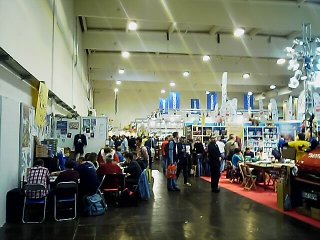 A standing tradition which was established at Essen years ago is the presentation of the new prototype game from ALEA for the upcoming year. This year ALEA has come with another big-box game, and with Notre Dame by Stefan Feld the players go back in history to medieval France. 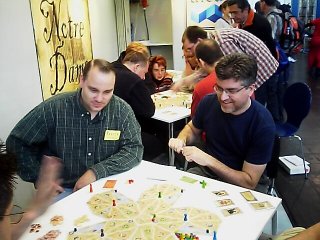 I actually was not the only one who had the idea that this game might be worth to have a look at, and so it happened that I once again met Greg Schloesser, Rick Thornquest and the others who were just embarking on an early morning playtesting session. In the game, each of the three to five player is in charge of a town quarter of Paris, and in this quarter each player finds a total of eight buildings each of which has a special function during the game. At the start, each player is assigned a number of action tokens which he may use during the game to activate the functions of each building, and each player also will receive a set of cards representing each of the eight buildings and also the Cathedral of Notre Dame which is situated in the middle of the gameboard. The game is played in three phases of three rounds each, and at the beginning of a new round each player mixes his own deck of nine cards and draws three of these cards. From these cards he chooses one and passes the other two cards to the player to his left, who again choses one and passes the last cards once again to the player to his left. This way each player will have a hand of three cards for the turn, and he has at least some degree of influence on the composition of his hand since he decided which card he wanted to hold. In turn, each player now plays one of his cards, followed by a second turn of playing cards. Then the third card on the hand of each player is discarded, and a new turn starts by the players once again drawing three cards from their stock and passing cards around. 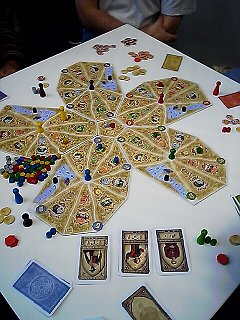 As indicated, each of the cards a player has at hand allows the activation of one of the buildings in a player's town quarter, and upon playing such a card a player may place one of his playing tokens in the specific building to signalize that it has been activated. The more simple of these buildings yield a production for the player, so that he will get either gold, victory points or new tokens for each token he has placed into such a building during the course of the game so far. Thus, if a player uses a building several times, he will accumulate tokens in the building and thus receive a higher income. An other card allows the activation of a player's counsellor, a figure travelling around the player's quarter and serving as a mobile token so that buildings may be activated which otherwise would not have been possible to activate due to the lack of fitting cards. However, the movability of the Counsellor is restricted, and thus he may not always be used to circumvent the usual card-based activation. Another building which may be activated is the coach station, and this building allows a player to send his Envoy figure to travel around the gameboard. The more tokens the station accumulates the further the Envoy may travel, and on his travels through town the Envoy may collect victory tokens which had been distributed on all crossroads at the beginning of the game. These tokens have different values and different colours, but the Envoy may not blindly collect tokens but must collect one of each colour before he is actually allowed to collect a second one of a colour he has already gathered. Also situated in each player's quarter is a river wharf, and here a plague of rats is slowly spreading. The collection of tokens by the Envoy or the activation of the Hospital building reduces the number of rats in a player's quarter, but each turn new rats arrive by the activation of special characters. Thus, at the beginning of a turn, three characters are drawn from a deck and after all players had made the activations by cardplay they may pay gold to have one of these characters to perform his special abilities. These abilities bring further changes on the gamboard, possibly influencing a player's distribution of tokens, his rat-level, victory points etc. However, each of these cards also has a rat symbol printed on them, and at the end of a turn the rat level of all player rises according to all character cards which were revealed for this turn. If a player reaches a rat level of 9 or above, he loses two victory points and also a token from one of his buildings, and since the rat level is not lowered automatically this may considerably weaken a player's position over several turns. Furthermore, a player also may chose to activate his park, and for every two tokens he can accumulate in his park he will receive an extra victory point whenever he gets victory points during the game And finally, a player also may play a Cathedral card, and this card allows him to place one of his tokens at Notre Dame at the center of the board. When a complete round of play is over, the Cathedral is evaluated, and the 12 Victory Points available at the Cathedral will be distributed amongst the players having tokens at the Cathedral, depending on how many tokens each player has placed there. After three full phases, the game is over and will be won by the player who has accumulated most victory points. Once again, ALEA has developed a rather tactical boardgame which stands in a very strong contrast to Um Ru(h)m und Ehre which was published in spring 2006. For me, Notre Dame seems to be one of the best ALEA titles ever published, since it united very sophisticated rules with a captivating topic and gives players a lot of possibilities to go for victory. I bet that many gamers around the globe will love this game! 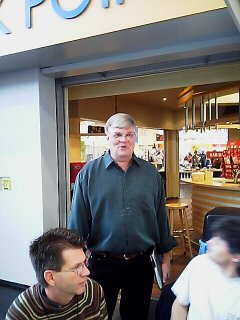 Also present was Richard Borg who watched the others testing Notre Dame, but I could not resist from grilling him about those promising clues which I had read about in the new Memoir '44 Pacific Theater Expansion pack. Richard confirmed to me that the new Air Pack would be published the following year, containing fighting planes and markers for quite a few different nations. Instead of making an Air Raid the players now will be enabled to fly an Air sortie from either an airfield or a carrier present on the gameboard, and Richard guesses that the impact on the playing system will be considerable so that people will love to re-visit any already played scenarios which might contain such features. 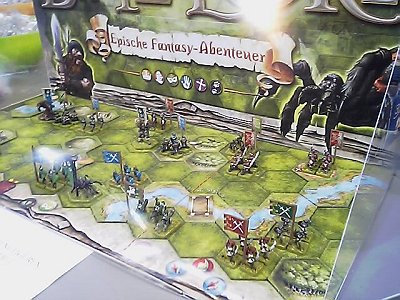 Talking about Richard Borg an his games: With Battlelore looming just behind the horizon, I had a nice chat with the people from DAYS OF WONDER about the game and its future. Although the game is based on Richard's Command a& Colours system, it has been quite changed in comparison to Memoir '44. One for the biggest changes is the fact that each player now is in charge of a War Council, chaired by a Commander and filled by people like a Cleric, a Wizard, a Rogue etc. At the beginning of the game each player choses how he wants to man the War Council, and he can either go for many present Counsellors or just a few with stronger powers. For each Counsellor specific cards will be mixed into a so-called Lore-deck, and the players will be able to draw from this deck and active their Counsellor's powers if they draw the right cards.  In the game itself the so-called banner-bearers are introduced. These are figures in each unit bearing a specific flag standard, and from each standard a unit's fighting strength and movement allowance can be deduced. Thus, the units get easier to handle despite the fact that the introduction of a much greater variety of units means a lot of different unit-specific rules. As a matter of fact, during an introductory session of the game I was rather captivated by this easy but nonetheless deep and sophisticated playing concept, and due to the numerous ways the game can be enhanced an enlarged I am quite sure that this new game may develop itself to be a chanllenger even to allmighty Warhammer. It is the great advantage of Battlelore that in essence it is still a boardgame (with very nice artwork and miniatures), and thus it is easier to learn and faster to play than Warhammer which has to rely on a much thicker rules compendium. Finally, I also talked with Mr. Hautemont from DAYS OF WONDER a bit about future developments of the game, and although there still is much secrecy on future expansions since the basic game has not even been released, there was at least some indication that the game will develop in a way as to include some character miniatures in the game so that unit might be strengthened by specific characters. But that is all still far in the future! For the time being, I was rather happy to have a first-hand glimpse at Battlelore here at Essen, and I would say that it is definately one of the most promising games which is presented here! 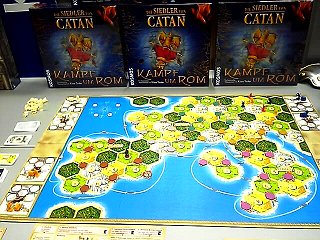 Making my way to the next booth, I had a short stop at KOSMOS to have a look at Klaus Teuber's newest creation, the new Settlers of Catan spin-off Kampf um Rom. I have been eying all these Settlers-products released over the previous years with some caution - not least due to the ridiculous Atlantis expansion sold last year. 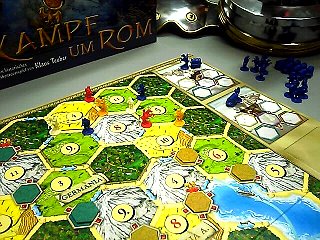 However, Kampf um Rom looks interesting indeed, with nice playing figures of soldiers, riders and wagons included, and featuring a large fixed gameboard showing the Mediterranean. From a look, this game seems to be at least worthy to have a go, and I am sure I am going to give you a review in the next few weeks. 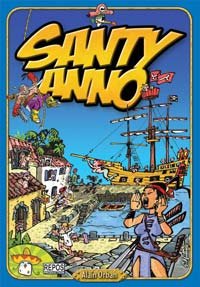 As indicated in my starting report on tuesday, one of the games I was rather eager to see was the new cardgame Santy Anno from REPOS PRODUCTION. Their smash-hit Ca$h n Gun$ from last year's convention was a rather entertaining and fast-paced game due to the fact that the players themselves were acting on the game with styrofoam guns, and upon learning Santy Anno I had to discover that once again the "Belgians with the Sombrero" had brought us a game with a high demand of player actions. In Santy Anno the players take up the roles of seasoned seadogs who are looking to find their ship after a night's drinking bought, and it has become a contest to be among the first to reach their ships since it will be the loosers of this contest (and the game) who will have to scrub the deck (and clean the table and glasses) for the next voyage. Thus, each player is assigned the identity of a pirate, and a total of eight ship cards is arranged in a circle on the table. Each of the player's sits next to one of the ships and may put a marker of his pirate on that ship, in it will be from this ship where he has to start movement of his pirate on the following turn. Each of the ship cards shows a ship which has four essential elements: the crow's nest, the sails, the hull and the nameplate. Furthermore, the ship cards also bear a number from 1 to 8. Each of the ship's elements is coloured differently, so that - of all eight ships placed on the table - there is always a pair of two ships which shares an element of the same colour. During a turn, a number of boarding cards will be revealed which must be acted upon by all the players simultaneously to find out which ship they are moving to. To resolve the movement, these cards show different elements of the ship which may either have no colour or a colour crossed out, meaning that either all players have to move to the ship with the same coloured element or that the movement is made by all players except those occupying the ships with the crossed out element. Likewise, the other boarding cards feature moving mechanism's centered around the ships' nameplates or numbers, or otherwise just on a colour which may also determine which ship a pirate must move to. 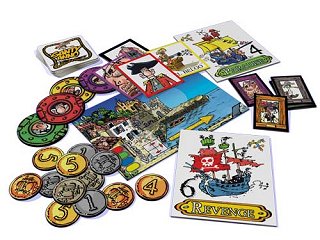 This shortened description of the movement procedure may not be easy to understand, but it should be sufficient if you can catch the general meaning that each boarding card makes each player move to a different ship. Since more than one boarding card have to be acted upon in a turn, a player need to plot his way among the ships in order to find out to which ship he should finally move, and he needs to do it as fast as possible since he must try to be among the first players to reach his final ship. Once a player has decided which ship he finally needs to move to, he moves around the table, sits down on the chair next to the ship in question and may put his player's marker onto the harbour board to signalize that he has finished movement. Here the real fun starts, since usually the players start running around quite simultaneously. Since no direction around the playing table is prescribed, this usually results in a lot of chaos - and this is even strengthened if one player has made a misplotting and possibly wants to run to the wrong ship. Once all players have finished, it will be evaluated if each player has acted correctly on the current boarding cards and has moved to the right ship. Each player who has found his correct ship then is awarded a gold coin, the value of it depending on how fast he was to reach his final ship. Here the sooner players get coins of higher value, whereas the others may receive nothing or just a single coin. Staring another round, the game is continued with new boarding cards (one card more than last turn) and keeps running until five rounds are completed. Then the players will count their money and the player with most money will be the new Captain and win the game. However, as known from Ca$h n Gun$, the rules do not stop here, but instead the guys from REPOS have thrown in a bunch of cards and ideas which expand the game. Thus, on the one hand you get additional boarding cards, making movement of the players dependent on even other factors like the position of Coco the Parrot on each of the ship cards or a random move of all players for a number of ships to the left or right. Even more confusion still is added by the action cards which may be added between the third and fourth boarding card, serving as further obstacles by possibly reversing the order of the following cards or forcing the players to run around the table backwards… As you might see, Santy Anno may even more be qualified to be a "Beer'n Prezels" game than Ca$h n Gun$ last year. Although the game contains alternative rules which make the running around the table unnecessary, it is exactly the element of movement from which the game derives its fun. Fast associative thinking is the key element of the game, since the players will need to plot their course among the ships fast in order to have a chance to win higher gold coins. Difficulty is added by the fact that the number of boarding cards increases during the game, and if you include all additional rules it becomes quite a teaser to keep a correct overview for all the moves a player needs to make. In a way, Santy Anno compares to Friedemann Friese's Turbo Taxi which was released in 2005. That game also was centered on fast thinking, and what is more both games also are similar concerning the fact that absolutely no strategic element is included. Santy Anno is meant to entertain, and if you take this fact as granted and do not expect any strategic element you might otherwise expect from a cardgame you will not be disappointed. Provided you have enough space and solid furniture, this hunt around the table means a lot of fun, and especially if a higher number of players participates the results often are hilarious. Finally, REPOS PRODUCTION also took up an another trend they established with Ca$h n Gun$: together with Santy Anno they handed out a special Blackbeard-Expansion at the conventtion, featuring rules which block a ship in each round for the movement of the players and which just result in even more chaos by the fact that several players now may have to move to the same ship. But knowing the taste most of you share for the discovery of some even more obscure games, let us now have a look at something so unusual that even I was bewildered to see such a concept come to life... 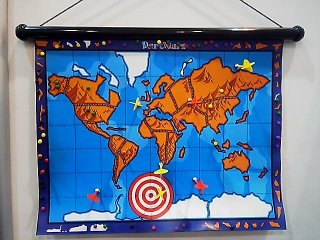 In the game Dart Wars (!!!) by the small french publisher SQUALE GAMES the players have to battle for world domination by throwing magnetic darts onto a wall board. By hitting the areas on the map, the players place and move armies, and depending on the number of participants and their skills in throwing darts such a game can take between about half an hour and up to two hours. To my taste, this kind of gaming is a bit of an unnecessary twisting of standard strategy games. While it is true that the idea is innovative and rather unusual, the player strategic options quickly will be shown their limits if the players' throwing skills are no match for the game. To my mind, this game only appeals to core-fans of the dart sports, and with a price of 30 Euros it is a bit too pricey for a neat Essen curiosity. 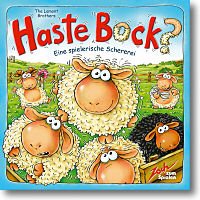 Something I announced earlier is the the Sheep of Shear Panic are back, but not only the german publisher ZOCH has taken them into their program but there also exists an english version from MAYFAIR! 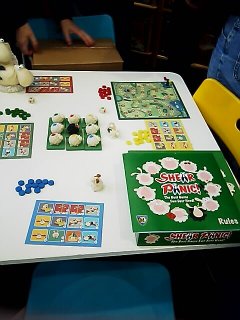 However, to my mind the version by ZOCH (which includes english and french rules!) with its fixed board and the graphical design looks definately better, and the game now also contains variant rules for only two players. Otherwise, the rules did not change much, and thus you should not be misleaded by the cute design of the gamebox. It still remains a strategy game with planning demands not suitable for rather young players, and here it may be hoped that possible buyers will heed the age recommendations given on the box since I would agree that the game is not suitable for players below an ago of 10. But now, reaching 0:10 AM over here at Essen and coming to the end of this typing session, let us turn a final page for today and join a sinister circle of travelling companions in their coach on their hurried Kutschfahrt zur Teufelsburg. This new cardgame by ADLUNG features both german and English cards and rules, and it is playable for 3 to 10 players but especially suitable for larger groups between 5 to 8 players. 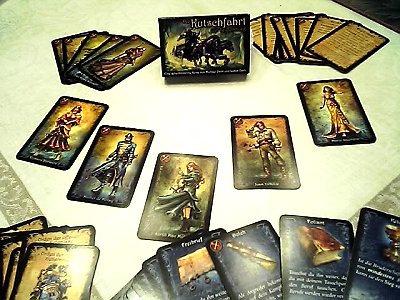 In this game, each player assumes the role of a character sitting in this fast-driven coach, and each of the characters is secretly assigned two cards depicting both his profession and his membership in one of the two available secret orders for this game (membership in both orders is evenly spread). Furthermore, each player is assigned one object card as hand luggage, and these luggage cards feature a number a artefacts with various powers and furthermore three goblets and three key cards. During the game, the players will have to find out which other players also are member of their secret order, and each of the secret orders has as its goal either to get the three goblets or the three keys into their possession. The game then is played in turns, and during a player's turn he will usually chose between doing nothing, offering another character a the trade of an object or attacking another character. When offering an object for trade, the player receiving the offer looks at the card and then decides whether he wishes to recline or to accept the offer and give back another card from his hand. If the offer is accepted, both players then look at the cards they received whether they have any special functions which must be revealed after a trade, but if that should not be the case the simply keep silent about the nature of the object exchanged. If attacking another character, all other players will have to chose which character they want to side with in the upcoming conflict, thus determining the basic strength of the attacking and defending side. The stronger side will have won the combat and the winning attacker or defender now may either look at the looser's profession and secret order card, or he may look at the looser's hand luggage and take one of his object cards. However, a combat usually is not simply decided by simply adding up the number of characters involved on each side, but instead, the players are allowed to use the powers of their objects or special abilities of their professions. These special skills and powers encompass an additional strengthening of one side or the other, the abrupt ending or even the full avoidance of the combat or the removal of characters from the combat. Quite unexpectedly, the player's may decide to use any of their powers at any point during the combat, so that there is no fixed order in which the players have to announce what they are going to do. However, once all players have announce that they have finished, the combat ends and the already mentioned consequences are enacted. However, the objects' powers and professions' abilities do not stop with possibilities to influence the outcome of a combat, but they may also have influence on the conduction of trades. Thus, some cards allow the trade of more than one object, a chain trade involving all characters or even an exchange of profession cards. Once again, this are only examples for the cards available in the game, and thus there is a great variety of special powers which may be used to influence the usual course of the game. However, whereas objects may be re-used as often as desired, some professions have abilities which may only be used once unless a specific card allows the re-activation of a profession's ability. The game starts with a phase of careful scanning, with each player trying to deduct who his allies might be. Once a player feels confident enough to win his first combat, quarrels will erupt which increasing intensity, and sooner or later at least some of the players will have a very clear view of the identities of their allies and enemies. Then follows the most difficult part, the collection of the three objects needed by each secret order to win the game, and once again the players will try to acquire the needed objects either by force or trade. If a player feels confident that his secret order has acquired the required three objects, he may announce that his secret order has won the game and name all his companions which are in the possession of the required objects. All players then reveal their alignment and hand cards, and if the announcement was correct, that secret order will have won. Otherwise, as might be guessed, the other side will have won. The variety of objects and professions in the game at first is a bit confusing, but it may be reduced for the first games and once players have gotten grip with the game mechanics the left out cards can easily be added. The players then will experience a rather unusual and challenging deductive game, which has a great entertainment value especially if played in a larger group. The excellent graphics strengthen the brooding and sinister atmosphere on this doomed voyage, and once begun the coach will not stop until the players' horses are totally exhausted. Exhaustion ! That's the key word ! I am signing off for tonight - need to get some sleep ! Friday, 20th of October This morning I had a long chat with the press represantative from HASBRO to find out some more details about the new series of author's games published by PARKER, and here I was told that HASBRO has recognized the fact that the german games market strongly depends on on games from well-known authors and thus they once again want to put a stronger emphasis on producing games which might reach not just the usual family gamers but also some of the more enganged hobbyists. 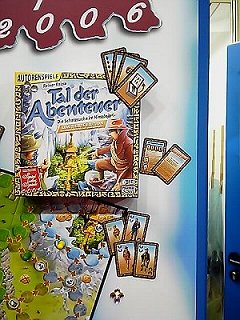 Here, the new game Tal der Abenteuer is meant to be the first game in this series, and to emphasize their new approach PARKER actually has produced to versions of the game. One version will be distributed through major stores and discounters, whereas another "special edition" will be sold strictly by small games stores. This special edition contains eight additional playing cards which shift the focus of the game quite a bit to the strategic side, and by this PARKER hopes once again to serve gamers they have last reached with Rheinländer several years ago.  Putting even more emphasis on this new development, HASBRO also brought the prototype of next year's author's game with them to Essen, something I cannot remember HASBRO ever did before. This game will be created by Wolfgang Kramer, and it was presented to me under the provisional title Tribes. I was lucky to get a detailed introduction to the game, and it is centered on the time of the Invasion of the Barbarians in Europe in the middle ages. The gameboard is an abstract map of Europe, and during the game the players put tribe markers into the "countries" on the map by playing cards showing either the country or a row of spaces on the gameboard. Points are scored by placing the last tribe marker in a country, and each time a few countries have been filled all the countries on the gameboard will be evaluated so that the playerswill receive additional victory points depending on how many tribes they have in a country. However, to represent the great migration, a player may also opt to move one of his tribes ofer an unbroken chain of his own tribe markers to an other open space, and this option will be needed especially in later phases of the game since the gameboard will have filled with tribes. A tribe may also be used to attack an other player's tribe, and such a combat will be resolved in Diplomacy-style by determining how many other tribe markers can lend assistance, but the players also may use their hand cards to enhance their chances to win the battle. The game is a game of majorities, but the rules offer some novations which make the game different from a game like Rosenkönig which might look comparable at first sight. PARKER is putting special efforts in developing next year's game early in order to have a chance to present it the the juries of the major games awards, and to me it sounded like their new game already only needs some minor finishing touches. 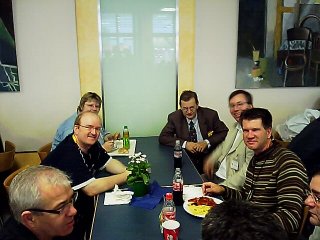 Rememebering a special meeting at noon, I next went to the cafeteria where I met with the other committee memebr of the International Gamers Awards present at Essen. Each of us has quite a busy schedule for his days at the Convention, but since at no other point of the year so many of us are united at the same point we usuall meet at Essen on friday for lunch to discuss some IGA matters.  And once again, we succeded in getting quite a few of us together: Greg Schloesser, Mik Svellov, Andreas Keirat, Ronald Hoekstra, Ferdinand de Cassan, Stuart Dagger, Ben Baldanza, Rick Thornquest and Alan How where attending this year, and it also always a great sight to have so many people of or committee toegether. Leaving IGA matters for the time being, you might also ask what a convention would be without special convention goodies. And here I might have something that quite a few of you might find interesting. I am quite aware that the french game Dungeontwister has found quite a few fans in its few years of existence, and thus they now are distributing a special ESSEN 06 promo figure - he PURPLE DRAGON!  But now, let's do some gametesting... A game which attracted me by its nice, comic-style looks was Krumble! by the small italian publisher TENKIGAMES. The game actually is a perfect example for the high quality of graphics which even small, rather unknown publishers reach these days, but the good looks of the game also made me interested whether it would be interesting to play as well. 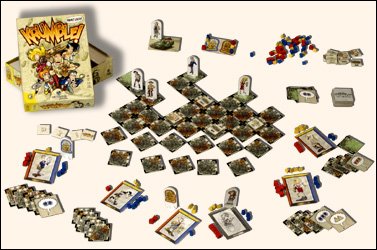 In this game the players take up the roles of daring adventurers who have entered an ancient temple in the midst of a jungle in search of two famous statues. Having reached the central chamber and grabbing the status, they hear a small "click" sound and suddenly the ground begins to shake! With crumbling sounds starting everywhere, the temple begins to collapse and the players have to run for their lives to get out unless they want to be buried within the crumbling building… At the start of the game three rows of temple tiles (rooms) are aligned on the table, with the size of these rows depending on the number of players participating. Each of the temple tiles used has two entrances and two exiting doorways, and the temple tiles all must be aligned in a way so that the exit doorways always point into the same direction - the escape direction. Each of the players places his playing piece in one of the rooms at the first row, and furthermore each player receives a character card and six coloured energy counters for each of his adventurer's abilities (Strength, Agility and Knowledge). During the game, the energy level for each of these abilities may never be above 6 or below zero. It will be the aim of the players to get out of the temple with as much energy counters as possible, since the player with the highest total of counters will win the game! Finally, each player receives one temple tile showing a temple-exit and four additional randomly drawn temple tiles, and once all needed counters have been placed at hand the game may start. The players take turns (with the last player becoming the new start player after a round has been played), and during his turn a player may decide either to make a movement or rest. If a player moves, he must first draw a temple tile, then play a temple tile from his hand by adding it to the temple laid on the table, then move his playing piece one room and finally check whether a "crumble" takes placed. If, on the other hand, a player decides to rest, he draws two temple tile, plays one of them accordingly recovers some lost energy. When adding new tiles to the temple, the general layout must be kept, meaning that all new tiles also must be placed in a way so that their exit doorways point into the general escape direction. To move his playing piece onto a new temple tile, a player has to check the exit doorways of his current temple tile which kind of ability symbols are printed at the exit he wants to use. He has to pay the energy counters printed on the exit doorway in order to move his figure through the exit, and thus a player's energy slowly decreases unless he chooses to rest and refresh. The costs for moving into a new room may increase even more if another player has used an obstacle tile. Some of the tiles in the deck of temple tiles are no rooms but obstacles, and if such an obstacle is placed into an empty room it increases the energy costs a player needs to pay to enter the room. However, an obstacle also may be played at a room already containing one or more adventurers, but here the adventurers have a chance to avoid the payment of additional energy by rolling with one dice lower than their current energy level of the ability in question. Although unlikely, an explorer also can decide to move one step backwards, but here he has to pay no energy costs for making such a move. As said, a player may also decide to rest and recover, and to do so he must discard a tile from his hand. If he discards a room tile, he receives points according to the two exists of the room. Should an obstacle tile be discarded, the player recovers the number of points marked on the tile, and in the case a temple- exit tile is given up the player receives three points of his choice. However, the real fun starts once a player has finished his movement. He then has to check whether there is a row of temple tiles three rows back from the tile he is not occupying, and if this should be the case the tiles crumble and the whole row of tiles is discarded! Any explorers still present on this row turn into ghosts for the rest of the game, but they still can participate and even have a possibility to win. During the game a count is kept of how many times such a crumble has taken place, and only after the third crumble has happened the players are allowed to play an exit tile. However, the third crumble also means that the temple will now collapse even faster, and thus a player now has to roll a dice after his movement. If the result means an additional crumble, a further row of temple tiles may collapse in addition to a row which might already have collapsed due to the three-rows-back rule outlined above. Still, let's not forget why the adventurers have entered the temple in the first place: they wanted to get the two Sun and Moon statutes. At the beginning of the game each of the statutes is assigned one ability marker of each of the three kinds, and whenever a player either pays three energy points to use an exit doorway or enters a tile containing an obstacle he may take possession of one of the two statues. At the beginning of the game the statues are placed aside, but as soon the players have taken possession of one of them the will be handed from player to player if the prescribed conditions are met. A player in possession of a statue may use the energy markers assigned to the statute to pay for using an exit doorway instead of paying with his own energy tokens, and the statues get stronger during the game since each time a player takes possession of a statue he has to place one of the energy tokens he just used onto the stockpile of the other statue. The players can exit the temple through a temple-exit tile, and once out of the temple the playing piece of the player is placed in the jeep where he waits for the game to finish. If the player succeeded in getting out a statue with his character, he may not take back three energy points of his choice, and while waiting for the game to finish he also spends each round resting in the car! For each turn in the car, the player names one of his attributes and rolls a dice, and if he succeeds in rolling higher than his current energy level of the named attribute he will receive an additional energy counter. But before getting to the ending, let us turn back to any poor characters which might have been turned into ghosts. A player has to discard a number of energy counters if his character becomes a ghost, but during their turns the players of these ghosts now may freely move their ghost-characters through the temple to rooms occupied by characters still alive. These characters are haunted by the dead, since a ghost chooses one of the characters in the room, names one of his abilities and rolls a dice. If he rolls equal or less to the adventurer's current energy level of that ability, the ghost will drain one energy from the character and take it for himself. However, the drain also may fail, and in this case it is the ghost who looses one energy while nothing happens to the adventurer. The game ends once all characters either have left the temple or have been turned into ghosts - who may not leave the temple! The game is won by the player whose character/ghost is left with the highest total of energy points, but if there is a draw it will be a living adventurer who wins over a ghost, an early survivor who wins over a later one, and a later ghost who wins over an earlier one. The game features rules in Italian, German, English, French and Spanish, but although the texts are well written there have been one or two possibilities for misunderstandings which needed to be remedied by switching from the German to the English rules and comparing their wording. Once understood, the game is fairly easy to play, and as soon as the race has begun a nice competitive spirit grabs the players who want to get out of this doomed temple as soon as possible. Although each player starts with a temple-exit tile, he will certainly not be able to use the tile very early in the game since the other players keep a system of checks and balances as to prevent an early winner. Here especially the obstacles are bothersome, since they may cost a player quite a lot of energy tokens which he would otherwise have needed to win the game. Some strategic options are available to the players while racing through the temple, but it must also be said that the game certainly puts a high emphasis on the luck factor. Temple tiles are drawn at random, and quite a few decisions are made by a roll of the dice, so that a player might get away lucky and escape with many energy tokens. Still, the layout of the temple needs to get used to, and thus a player needs a keen eye unless he wants to be surprised by an unwanted crumble, and furthermore a player should not feel too certain of victory, since the placing of some nasty obstacles short before his temple-exit may prove devastating on his efforts to win. To sum it up, Krumble! is a nice, entertaining family boardgame which owes a good portion of its attractivity to its nice artwork and the racing spirit created in the game. Keeping this in mind, it is light enough to be played before or after getting down to a heavy-brain teaser, and it offers enough entertainment so that its replay value should not be underestimated. 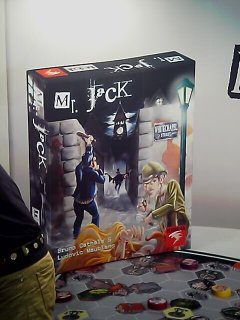 Being hungry for another game, and scanning the convention halls for outstanding games from smaller publishers, I remembered Mr. Jack from HURRICANE GAMES since their booth looked both attractive and crowded. It is a new game from the well known authors Bruno Cathala and Ludovic Maublanc, produced by the new swiss publisher HURRICAN GAMES and it takes up the famous story of the Jack the Ripper who committed his crimes in the district of Whitechapel in London 1888. In this two player game one player takes up the Role of Jack the Ripper, whereas the other player is named "the Detective" and will try to capture him. The gameboard shows the district of Whitechapel and is divided into hexagonal spaces, most of which are open streets but a few of them showing open manholes or gaslight lamps (also considered to be street hexes) or houses and parks (considered as blocked hexes). When the game is set-up, several gaslight counters with glowing lights are distributed on several of the gaslight spaces, and also two of the open manholes are covered with tokens. Also distributed on the board are the eight character figures, half of them standing on spaces next to lit gaslights ("illuminated hexes"), whereas the other half is occupying hexes away from gaslights ("dark hexes"). There also exist four streets leaving the district, but two of these will be closed at the beginning of the game by police barriers. To finish the preparations two decks of cards are separately shuffled - the character cards and the character alibi cards. From the deck of character alibi cards the Jack player will draw the upper card, look at it and then keep it face down in front of himself. It is the character shown on this card whose identity Jack has assumed for this game, and it will be the task of the Detective to find out Jack's secret identity before Jack either succeeds to leave the district or the night ends after eight rounds of play. 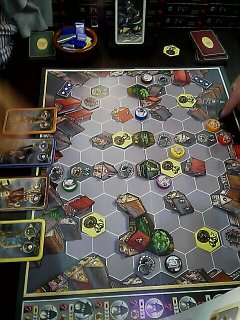 At the beginning of each turn, four character cards from the shuffled deck are revealed. In turns 1, 3, 5 and 7, the Detective now may chose a character and performs an action with him, then Jack goes with two characters, and finally the Detective plays the last of the four available characters. In the other turns, the order is reversed, with Jack taking the first character, then the Detective choosing two characters, and again Jack playing the final one. After each two turns, when all eight characters have been activated once, the deck of character cards is reshuffled so that again all eight characters can act in the two turns to follow. However, at the end of each turn, the Jack player also must tell the Detective whether there is a witness or no witness, meaning that the character Jack is impersonating either stands next to a lit gaslight or next to another character token. Thus, for example, when Jack says that there is a witness the Detective now may deduct that all characters standing on dark hexes are innocent, and to keep track of their innocence he may turn their character figures to their other side. A final point which needs to be observed at the end of the first four turns is the fact that the gaslights in the district are running out of gas, so that in the first four turns the gaslights situated closer to the outer edges of the district one by one will shut down. In the end, this leaves only two active gaslights in the middle of the gameboard, and it will then become more probable that Jack may announce at the end of a turn that there is "no witness", meaning that the character he impersonates stands in the dark and not next to another character. Getting to announce "no witness" is very important for the Jack player, since only if he succeeds in making this announcement he may try to leave the district through one of the two open exits during the next turn. As said, Jack wins the game when he succeeds in either leaving the district or is not caught within eight turns. On the other hand, the Detective wins the game if he succeeds in moving a character onto the same space occupied by Jack's character and raising an accusation. If the accused really is Jack, the Detective has won, but if he isn't Jack it will be the Jack player who has won due to the Chaos arising from the wrong accusation. However, we have not yet touched the central part of the game rules - the characters and their abilities together with the covered manhole tiles and the police barriers. Each character has a movement allowance (in most cases to move up to three hexes), but each one also has a special ability:
As you might guess, it is these special rules for each character from which the game draws its main attractiveness, but already the rules for the illuminated areas around the gaslights and their stepwise darkening is not only an interesting rules twist but a fascinating way to carry the feeling of this dark and foggy night directly to the players. During the game, each player will try to make most effective use of the available characters, but especially the Jack character must be careful neither to expose his character too early nor to leave a possible early exit from the district out of calculation. The players each will try to move the characters in a way suitable for him, and the more the game progresses the more characters will be proven innocent for the Detective.  This game is famous in France since it was first released as a limited edition of 250 copies under the name Une Ombre Sur Whitechapel, but now it has come in a revised edition from a new publisher in order to make the game available to a bigger audience. My friend Jean-Marie from France was able to provide to following information: "The game was displayed as a prototype to some events in France and even got a review in "Des jeux Sur Un Plateau" even before being completed as a game. Despite the authors' reputation it found no editor since no one wanted to publish a 30€ two-players game. So there were but no choice than to self-edit it, but the 250 copies of the limited edition were sold very fast. Soon enough, the very few copies sold by owners were reaching top prices but still no editors would bet on a two-players game, especially considering there are only 3 or 4 editors in France and two of them don't do games, they just translate them. So HURRICAN was founded, almost especially to publish and edit "Mr. Jack". And about the name change ? It has two reasons:
The names of the authors already are a trademark for high quality games, but playing this game here at the convention revealed that it is definitely a must-buy not just because of its great artwork but also for its playability. Outside the famous KOSMOS-series of two player games there rarely was a game which would stand up to the quality of any of the KOSMOS products, but now Mr. Jack does not only offer a playability known from the KOSMOS games, but also is a very strong challenger for each and every of these games since it offers a high degree of strategy coupled with playing fun and interaction alike. Thanks to HURRICAN GAMES for making this masterpiece available, and also for including English and german rules amongst French and some other languages! That's real globalization! 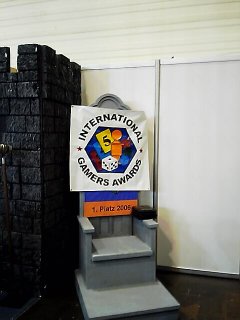 And this also should be a good transition to my last topic for today, the awards ceremony for the International Gamers Awards!  Once again our IGA team met, and as it has been good practice in previous years once again Greg Schloesser presented the promotional speech for the awards and its winners.  It is actually nice to see that public interest for the IGA s increasing each year, and so this year a well sized-crowd once again waited for the handing out of the awards. 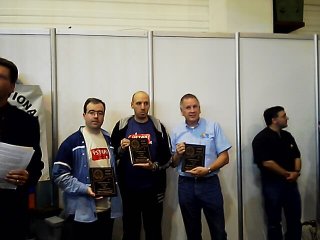 In the multiplayer category, the IGA 2006 went to Caylus by William Attia and produced by YSTARI GAMES and RIO GRANDE. Thus, quite astonishing for a publisher who has come to Essen with a small edition of their first game last year, they now were awarded not only with the DEUTSCHER SPIELE PREIS as one of the most important german awards but with the IGA as well! 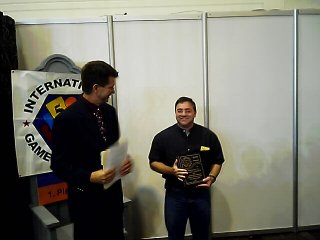 For the first time, the awards for both the two-player category and also the Historcal Simulations went to the same game: Twilight Struggle by Jason Matthews and Ananda Gupta and published by GMT. However, since authors and representatives could not attend the ceremony, Ben Baldanza received their awards in absence.  Well, and that should be all for today. 01:43 AM over here - late again... Saturday, 21st of OctoberIt's saturday evening already, only one more day to go! Time is running, and there still are so many things I would like to tell you about. However, as always I can only bring to you a very small impression of the things happening at Essen, but - scanning through my guestbook - this at least seems to work out quite well for all of you who cannot attend. Anyhow, let us start with something new - the Remote Controlled Frank! As said, I today took the time to scan through the guestbook, and since a few of you have expressed some points of interest on which they wanted I felt a strange pull this morning to comply to a few of these wishes. And so, I felt a strange compulsion this morning to return once again to the DAYS OF WONDER booth to find out a bit more about Battlelore since so many of you seem to be starving for news on the game. 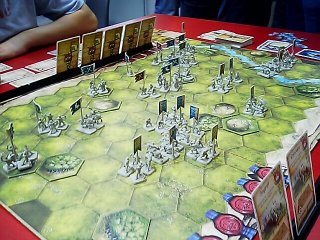 Once again unpacking my mobile phone cam, I first made another shot of the gameboard, and as you can see it looks pretty much like the board of Memoir '44 with the exception that the colouring has changed a bit. I did have a look at the rulebook, and here I also found a list of landscape tiles to be included in the game, so that - as expected - you will find typical landscapes like woods or hills but also more specific tiles like a healing spring, a tavern, a circle of standing stones, a fort and so on. As indicated on thursday, a very important role in the new game takes the War Council of each player which is manned with different characters. The attributes and abilities of each character do not only have a direct influence on the troops on the battlefield, but they also may allow the player to use these more specific landscapes with a special effect. Thus, a healing spring may be used to heal a wounded unit if the player has a cleric, whereas troops in a tavern may be sneaked to another hex if the player has a Rogue in his Council. A warrior also might prove to be useful, since the presence of a warrior allows the player to train troops standing in a fort, upgrading their fighting powers and thus changing the colour of their banner. 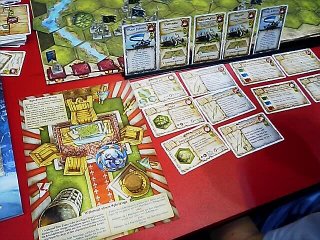 If you take a closer look at the War Council board, it also offers two special positions which stand a bit offside at the lower end of the board. On one side is a cage, and here a player may chose to put markers for a monster he might whish to add to his army, whereas on the other side is an additional chair on which a special counsellor may take place. This place for the special counsellor remains empty in the basic game, but DAYS OF WONDER actually is planning to release expansions which will allow the players to place somebody on that space. Talking about expansions, additional miniatures will be released in either blisters or army boxes, but as DAYS OF WONDER has promised the game will not be a collectible miniatures game like Mageknight where people have to rely on their luck to see which figures they might get. As for new missions, these will be included in Adventure Modules, something many of us still know from former role-playing days. Thus, it seems like the missions might be interlinked to form some sort of major adventure, but I am not sure whether this will be true.  Looking also at the rulebook, it first seemed a bit thick, but when giving it closer scrutiny I could quickly discover that it is spaciously printed with many examples and ample space to allow a wide presentation of the rules. As always with DAYS OF WONDER, the graphics are simply outstanding!  I also found a page displaying all miniatures available in the basic game. I know the quality of the image is not too well, but I hope that you might still find a look interesting. The game will contain human cavalry, infantry and archers, Goblin archers, infantry and lizard riders, Dwarves with crossbows and dwarfish medium and heavy infantry and finally a Giant Spider monster. Finally, let me tell you that I am going to receive a special preview copy of the game within the next week. Thus, you may expect a first review of the game to go up here at the G@mebox by the middle of November!!! Still feeling this strange pull emanating from my guestbook, I then went over to the booth of QUEEN GAMES to have a look at the news they present at this year's SPIEL. 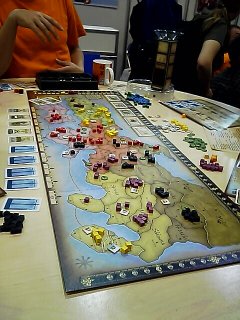 Starting with their biggest news, I first had a look at Shogun, a game from which a few of you might remember that a poster announced its development already at the SPIEL 2005. This new game is based on the playing principles known from their earlier publication Wallenstein, but quite a few new rules have been introduced so that the game itself has changed quite a bit. Thus, the geographic location of the game now made it necessary for the players to have the options of sea movement, and so some provinces bordering the sea offer movement possibilities to provinces on other islands. Especially important also is the fact that the board actually is two-sided, with one side representing the beginner's version of the game with less potential for military conflicts, whereas the other side shows the same landmasses but with other provincial borders, establishing much more conflicting positions and movement possibilities. Also, characters have been added which the Daimyo (Lord) representing each player may assume, and each of these characters has a special ability which may be used by the player to improve his position. Adding these greater news up with some smaller improvements, the game has introduced some quite essential changes compared to Wallenstein, making it even more a demanding strategy game with a playing time of two hours and more.  Also new at QUEEN GAMES is Alhambra - Das Würfelspiel, another stand-alone spin-off of the successful Alhambra-series which now uses dices to find out which new buildings may be available for construction. However, the game may also be played as a expansion to the basic game of Alhambra, with the dices replacing some of the building tiles.  Finally, QUEEN GAMES also presents Feeling free again, I once again wanted to present you with another game from a small publisher, and thus I started fighting my way through the rising crowds to another convention hall. Compared to thurdsyday and friday, the convention halls today where hosting at least double as many people as in those days, a factor which might be due to the fact that we have no school holidays this week. Las years the visitors were more evenly spread over all four convention days because of the school holidays, but this year the children had to wait for the weekend to come to the convention, and so this day had seen the people which did not have an earlier chance to visit. But let us now turn to a game which might have a high potential to be my favourite game for this year's convention. With TUSBAS, a small new publisher from Denmark has found his way to Essen, and with them they have brought their new game King of Chicago which leads up to six players deep into the Mobwars of the roaring 1930s. In this game, each player starts the game with a car, a small business which may be either a liquor shop, a casino or a brothel, one mobster and some starting cash and capital. In turn, the players use their cars to drive through the streets of the town to acquire new counters of henchmen, booze and ladies, and depending on which and how many counters they might get of each kind, they will try to open new businesses in either of the three aforementioned branches. The businesses now may be either small, medium or big ones, and the bigger the business a player wants to open the more of the counters he has to possess. If a player has accumulated enough counters to open up a business, he drives his car to a fitting building area, selects the business he wants to open from the common stockpile, pays the fitting counters to the bank and takes the deed associated with this specific business. From now on, the business will generate an income for the player, and thus he will receive additional cash after every four turns when an evaluation phase takes place. Instead of opening a business, a player also may decide simply to enlarge his turf by placing a token of his colour on an empty building lot, and from now on that turf will yield and additional income of protection money.  However, the other players might get jealous of a very successful entrepreneur, and thus they might decide that it is the time to show him who might be the real boss in town. Thus, a player might squeezed a few of his mobsters into his car, and then drive to a business or car belonging to another player and challenge him for a shootout. In this shootout, the players will each will roll a dice with the final result being modified by mobster abilities and possibly the size of the attacked business, and the shootout round will be won by the player with the higher result. Depending on the result, the looser will have to send one of his mobsters either to the hospital or the graveyard, and the whole shootout comes to its end once one player has no mobsters left. If the attacker of a business was the winner, then he may take the business' deed from the looser and thus take over the business, whereas all other results lead to a preservation of the status quo with the only change that a few of the mobsters might have been eliminated. Talking about mobsters, the player my hire them during the evaluation round which always takes place after four rounds of play. During this round, each player first collects his income and then draws a card from the random deck. This deck consists of several kinds of cards, with some cards bringing new tokens to the gameboard whereas some others might be kept by the players as special action cards for specific situations in the game. There is also a possibility that a player might draw a mission card, offering him some kind of mission in town upon the completion of which he will receive some additional money. However, of great importance are the mobster cards which may be also drawn here but which are not kept by the drawing player. Instead, the mobster cards are lined up for auction, and then one by one all the mobsters revealed in this evaluation phase will join the player who will bid most for their services. As indicated, the mobsters have special abilities like gunfighting or driving, but others may have more obscure skills like forgery which gives an additional income or a reporter who will reveal all of a player's mobsters hiding at a specific location. When all mobsters have been auctioned, one final auction will take place and this one will be for the control of the Police. The winner of this auction will be in control of the Police car for the next four turns, and using this car he may move through town and arrest other players cars or close their businesses - or threaten to do so and thus blackmail them to pay for not using the Police's powers. The game continues until one player has accumulated 10 victory points, and these points will be awarded for a number of reasons. Thus, a player receives victory points for his businesses (1, 2 or 3 points - depending on the size of each business), one victory point for each two mobsters in his gang, one victory point for each completed mission and one victory point for the biggest turf in town. To my mind, the game excellently captures the spirit of the dark and dirty business conducted by the crime lords of that time. There are many opportunities for the players to engange in different kinds of activities, and the game offers an even higher degree of interaction between the players due to the fact that the small gameboard automatically will lead to confrontations during the course of the game. It might not be the kind of familiy game which could or would be expected from a major publisher, but for a small publisher like TUSBAS the game really is a milestone and it would deserve to be known among a larger audience of gamers. Perhaps I should not keep secret about the fact that a few of the other well-known hobbyists attending Essen like Mik Svellov from Brett & Board or Greg Schloesser from the IGA did not think too much of the game due to the fact that it possesses a luck-driven engine requiring quite a number of decisions to be solved by a roll of the dice. Still, my own preferences do not exclude such a game if the other mechanics and the overall impression of a game make up for an element of luck, and to my mind the rather good impression of the playing mechanisms is strengthened by a very fitting graphical design which consists of nicely fashioned playing materials with cute cars and an interesting card design which in part uses old photographies, and thus I consider the game to be really worthwhile to try! If your interest should have risen after this short description, you might want to have a look at the King of Chicago Homepage.  Looking at my wristwatch and seeng the hours run past, it is also time to tell you about a few news which will directly influence the future of Kulkmann's G@mebox! Over the last few years, my old schoold friends Marco Klasmeyer an Ralf Togler and also IGA committee member Doug Adams from Australia have joined me as co-editors since the task of reviewing the increasing load of major news each year for me alone has become unmanagable. However, observing the trend in recent years that boardgames especially from France become more and more important to the global gaming scene, I now welcome long-standing hobbyist gamer Jean-Marie Baveux from Lille in France as a new contributor to the G@mebox. It is still uncertain how his engagement will be defined, but in future you will now and then see some contributions from Jean-Marie about major developments on the french games market! (on the picture above, you see Jean-Marie to the left, Marco Klasmeyer to the right and me in the middle). 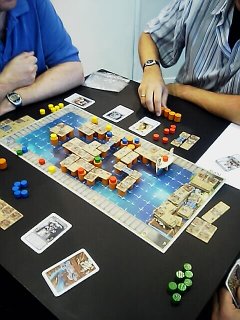 Having a bit of playing time left, I once again went to a major publisher who had a game on display which had caught my interest. Thus, I visited the GOLDSIEBER booth and played a testing round of their new boardgame Die Säulen von Venedig, a game the release of which I had eagerly awaited after the last Goldsieber boardgame Kreta in my eyes had been a rather weak product. In boardgames history, there already have been dozens of games dealing with Venice in one way or another, but if I remember correctly there has not been a game which actually has centered on the building of Venice. This now has changed with Die Säulen von Venedig, since this game focuses on the time when tar-coated trunks where driven into the ground of the Lagoon of Venice to get a basis to build the city upon. Thus, in the game the players take up the roles as builders trying to construct buildings in Venice after laying a proper foundation, and the game will be won by the player who has earned most victory points in this process. At the beginning of the game, each player is equipped with a five randomly drawn profession cards which will form his starting hand of cards and a number of coloured trunk-markers which he may use to mark single trunks which form the foundation for the buildings. The trunks and buildings themselves are placed next to the gameboard, and here the building markers are divided into their respective shapes since different kinds of building markers may be acquired by the players during the game. To finish preparations, each player also receives a starting stock of two buildings and then the game may start. At the beginning of each round of play, each player chooses one of the profession cards he has in his hand which he places face down in front of himself. After each player has chosen a card, all cards are revealed simultaneously and then - starting with the current start player - the player's in order may perform the action which their chosen profession allows. To build in Venice, a player first needs to play a City Councillor which allows him to add building tiles up to a certain value to his stockpile. Then a player needs to play a Trunk Worker who prepares a trunk with tar and rams it into a free space in the Lagoon, and finally an Architect may be used to place buildings - once again up to a certain value - from a player's stockpile onto trunks on the gameboard. For the erection of a building a player receives the number of victory points which are printed on each building, but a number of additional rules needs to be observed during the building process so that other players may be influenced as well. Thus, a player who uses a trunk worker also is allowed to place some of his trunk markers on free trunks on the gameboard, and although all player's can build on any free trunk regardless of the presence of a trunk marker, the owner of such a marker also will receive victory points when another player covers his marker with a building. Furthermore, when using the architect it is also quite advisable to check the spaces adjacent to all available building sites, since a player may score bonus points if his the squares and buildings on his newly placed tile match squares and buildings on neighbouring tiles. However, there is a number of other profession cards which may influence the game in other ways, and it is especially the use of this cards which introduces much variation and interesting changes into the course of a game. One of this professions is the Gondolier, and whenever a player uses his card he may take possession of the one and only Gondola waiting in the Canale Grande As long as that player is in possession of the Gondola, he will receive additional victory points each time a player builds a building directly adjacent to the Canale Grande. Another profession is the Advocate, and he may be used to place one of the cheaper buildings from a player's stock onto trunks already occupied by trunk markers without incurring victory points to the owners of these markers by contesting their legality. Still other characters are the Speculator, the Trader and the Inventor, since these professions do not conduct an action but instead are bets that an other player actually has played a City Councillor, Trunk Worker or Architect this round. If this should be the case, the player of such a profession will receive victory points as well. However, there also exist some low elements in the game, like the Saboteur who removes a building and allows his player to place trunk markers on some of the trunks re-appearing below the destroyed building, or the Beggar who does not have an action of his own but instead allows his player to duplicate the action an other player has gained from his position during this round. An interesting feature which also needs to be told is that the used profession cards actually are not discarded but instead are handed over to a player's left neighbour so that the card now becomes available for that player. This effectively serves to keep all important cards in rotation between the players, and it both balances the game and offers some strategic potential when a player has to decide whether it would be more beneficial to use a card or keep it and make it not available for other players. However, of the cards associated with the construction process more than one card exist, so that hoarding is not very useful here, and furthermore the starting player of each round has the privilege to randomly a card from another player's hand and handing back another card for it, so that even a card which was meant to be hold back might get into circulation again. The game comes to its end once the 60 trunks included with the game are used up, and the player with most victory points will have won the game. As described above, there are a number of possibilities in the game to get victory points, but the most important source to score a higher amount of points still is the placement of a building upon some free trunks. If the attributes of the adjacent building tiles are matching, a player's score may go up considerably by placing the right building at the right space, and such a high number of points cannot be scored with any of the other professions. Still, the strategic potential of the game is palpable, although the players need to play a game or two before the implications of the different actions will be fully understood. Also, player's need to learn that the ending may come quick without exhausting or even draining the stockpiles of buildings or the available Lagoon spaces. The available 60 trunks only serve to cover about two thirds, of the Lagoon, so that in the end still a major part of the Lagoon remains untouched. These lessons learned, the players will keep a closer watch especially on the current leader and the stockpile of unused trunks, and this will enable them to organise their play in a way to make best use of the strategic possibilities the game offers. 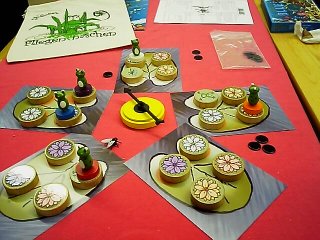 Heading towards the exit, my eye also fell on one of these rather oscure games from minor publishers for which the SPIEL is well known. Having cute little wooden frogs as playing pieces, Fliegen Naschen is a memory game in which the players have to get their frogs onto a leaf currently occupied by a tasty fly. At the beginning of a player's turn, he has to rotate the spinner which is placed within the circle of leaves forming the playing area, and then the player has to move his frog clockwise, hopping from leaf to leaf in order to get to the fly. Upon getting to a leaf, a player must land his frog on a blossom the downside of which shows the player's colour, and only if he remembered correctly from knowledge gained during previous turns where his colour is situated he may continue his turn and move to the next leaf. If he reaches the leaf with the fly, he gets to eat a fly (add one victory point) and ends his turn. the game ends upon a player receiving his third victory point. However, the way there is not as easy as it might sound, since some additional rules allow the exchange of blossoms and the aimed preparation of the playing area at the start of the game. Thus, the game definitely is more than a simple memory game! And with this trinket I also end my report of the third day of the Essen convention. I still need to think which games I am going to present tomorrow, but I guess that the choice I am contemplating about will offer some nice highlights for the final day! Sunday, 22nd of OctoberWow, time has flown by this year, and so we already have Sunday and the Convention is comming to its end. But before shutting its gates for another year, lets have another stroll through the sacred halls, and once again I hope that I have located for you some of the major and smaller wonders which otherwise would have been available only for visitors of the convention. 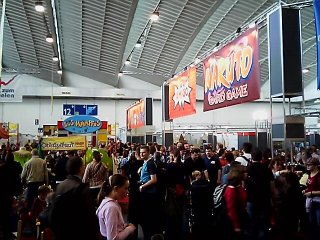 After the great success with the cute sheep in Shear Panic last year, FRAGOR GAMES now has come back with their new game Hameln, once again equipped with nine beautifully crafted figures (6 King Rats, 1 Emperor Rat, 1 Cat and 1 Pied Piper). However, in comparison to last year the box size has grown considerably, and this year the game actually included much more playing material and a stately sized gameboard. 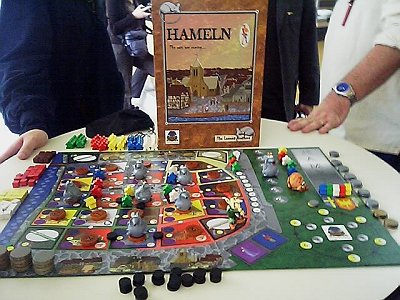 As the name and the figures suggest, the game plays in the medieval town of Hameln where the inhabitants were faced with an enormous rat plague. In the game, each player takes up the role as head of one of the town's families, and it will be the aim of the game to become the most influential family after three phases of play. The gameboard features the town of Hameln which is divided into four quarters, and each of these quarters consists of several houses which are either baker's houses, butcher's houses, cheese dairies, ale houses or influence houses. The first four of these houses are called "production houses" which may produce the associated type of goods, whereas the fifth kind of house yields an income of Florins (game currency) to their inhabitants. Two familiy members may occupy each house - one male and one female. At the beginning of the game, each player has two of his family members on the gameboard, one occupying a male space in a butcher's house around the town's central square and one occupying a female space in a different butcher's house which is likewise situated around the central square. The game then is played in rounds, with the players taking turns following the order how influential they have become. At the beginning, each player has the same influence so that a starting player is determined at random, but during the game the players may acquire more influence by occupying influence houses or buying influence, and thus the turn order may change following appropriate actions of the players. During his turn, a player has to perform one of the four available standard actions:
Activating a house always means that the active player activates the house not only to perform his own action but also allows the player owning the house's other occupant to perform an action with his family member as well. Thus, if the active player activates a male figure to produce, the family head of the female occupant now may prepare a child to marry. To prepare a child for marriage, the player now draws a wooden cube from a bag, and depending on the colour of this cube he may move either a new male or female family member onto the appropriate space of the church. If there are two children of opposite sex and belonging to different players available in the church, the option to marry become available and the player who performs this action ow may move one of his family members and his new partner from the church onto one of the free houses on the gameboard. To perform this action an initial cost needs to be paid by the owner of the male figure moving to the new house, and once occupied the new house may be used for production like any of the houses which were occupied sooner. The production a player accumulates may also be sold, and depending on the kind of goods a player has produced he receives a price of one to four Florins for each unit of goods he sells. However, a player also may decline from taking Florins for a sold unit of goods and randomly draw a rat trap instead. These rat trap tokens (each with a value from one to three) he stockpiles till the end of the game and they are one factor when determining each player's victory points. Talking about rats, the activation of a house also attracts the dreaded rats roaming the streets of the town. If an house is activated, a number of rat tokens needs to be placed on the alleys around the house, and the number of the tokens placed depends on a marker which had been randomly assigned to the house at the start of the game. If all four alleys around a house should become occupied with rats during the course of the game, the house becomes overrun by rats (signalled by a Rat King figure which is placed there) and may be activated no more until the overrunning situation might be ended. Here now a player's optional actions come into consideration, since a player may - in addition to his standard action - perform one of the following optional actions as well. Thus, a player may decide to purchase the car, placing its figure in front of himself and removing one rat token from the gameboard. If this removal should end an overrun situation for a house, the Rat King is removed from that house and it may be used for production purposes again. A player also may buy influence (the price depending on the situation in the game), and this influence is used to determine the order of players during a round and also may be beneficial at the end of the game. Finally, a player may also opt to bribe the Pied Piper by putting Florins onto one of the Pied Piper spaces associated with each quarter of the town. If the bribe at that space is higher than the bribes at each other quarter, the figure of the Pied Piper is immediately moved to that space. A phase ends when all available King Rats have been placed at houses on the gameboard. Now the Pied Piper comes into action, moving to the quarter with the highest bribe and removing all rats from all alleys in the quarter in question. The Pied Piper takes the bribe from his space for his services, but furthermore he demands that each player who has family members in the church (ready to marry) must pay him an additional amount of money. If a player cannot pay for one or more children, these children are removed from play and will score negatively for their family head at the end of the game. This way the game is played through three phases, and in each phase the maximum number of King Rats is increased by one. In the third and final phase, the last King Rat is represented by the figure of the Emperor Rat, but this figure only serves the purpose to remind the player's that play has reached the final phase. When the phase is over, each player receives victory points depending on his influence, his wealth, the value of his rat-traps, houses (not overrun!) with a family member and ownership of the cat. Ngeative points are awarded for each child stolen by the Pied Piper. The game then is won by the player with most victory points. A nice shot indeed! The Lamont brothers had received much praise in advance, and this was not least represented by the fact that Hameln actually was sold out before the SPIEL 06 even started. All 1000 copies were preordered, but to my mind all buyers will not only receive beautiful figures but likewise a well-constructed game. When learning the game it might be necessary to have a demonstration round in order to give the players a chance to understand the different scoring possibilities available in the game, but once the mechanism has become clear to everybody the game works smoothly and offers some neat rules. I especially liked the idea of sharing houses with other player's family members, meaning that spending an action to produce always caused another player to gain a benefit as well. Keeping an eye on the raising level of rats is also important, and thus a player may be well advised not to produce with too many houses unless he wants the streets of the town to be flooded with rats. As for the story behind the game, I think that - although the game has strong economic playing mechanisms - it captures rather well the spirit of the story of Hameln. To sum it up, I rather liked the new ideas the Lamont brothers have put into their new product, and I hope that this game might find a publisher like Shear Panic did. It would certainly deserve a bigger audience! Also, there is another chance to get one of the highly sought after FRAGOR games next year, since Gordon confided to me that they already a discussing a few concepts for a new release next year which still need a bit of finetuning. And - of course - the new game also will contain some beautiful figures since the inclusion of such outstanding playing pieces definitely has become an important trademark of FRAGOR products! 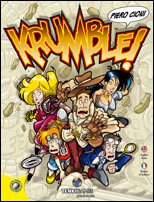 At this point, I would also like to re-visit one of my reviews from Friday, since I gave Krumble another testing today. The rounds I played today went a bit strange, with players getting an early possibility to leave the temple with a very high score of tokens left. This happened despite the fact that such a player was hampered a lot with obstacle cards, and I felt that the rules perhaps need a bit of fine-tuning to reduce the chance of such situations. One possibility is to mix the exit tiles into the deck of tiles instead of handing each player an exit at the beginning of the game. This will force players to stay in the temple longer, and if you couple this change with setting back the distance for a "Krumble!" from three to four rooms there is a major impact on both game length and player's strategy, since it now also becomes a very real option to possibly go back in order to reach an exit played by another player. Well, Krumble! offers some room for experimentation here, and I would recommend it to try varying some of these factors to see how the gameplay reacts. 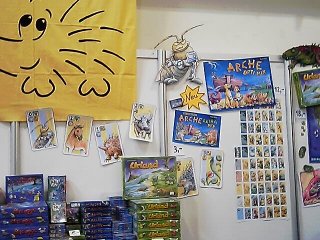 Another very pleasant task each year at Essen is to visit the booth of Doris & Frank, and although they have not published many new games over the previous years they usually have arrived with some nice little item to add to one game or another. This year, they have brought with them an expansion for their rather uncommon cardgame Arche Opti Mix, and with this new Arche EXTRA Mix the players now get the possibility to squeeze even more animals onto the ark. Quite a few of the new cards are new "standard" animals which may be loaded, and two of these - the Moonrat and the Porcupine - actually copy the special rules already available for skunk and hedgehog. However, there also are some more unusual creatures included, and so the players now may board with the Woodworm who who may open up a new cabin in the wall between two cabins, the Carnivorous Plant which counts as Provisions but which may eat smaller animals or a Snowman who wants to be saved as well. The new cards are cute to look and and increase playing fun, and since the rules for Arche Opti Mix always were a bit cumbersome the also included special reference cards are especially appreciated! 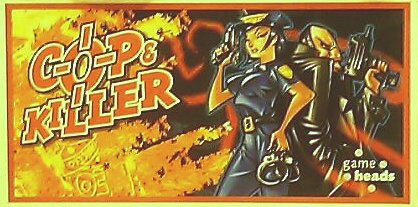 There is also some big news for those of you who are a bit knowledgeable in games history, since the newly established small publisher GAMEHEADS actually is planning to release a new game containing a Dart Gun which is going to be used in shootouts between the players. As some of you might remember, the old LUDODELIRE classic Supergang actually featured a Dart Gun used for shootouts, but the company now is out of business for following some strange economic decisions like the release of new games just after Christmas and thus just after the biggest selling time of the year. Remembering an article from the Spielbox, even AVALON HILL tried to get a license for Supergang but did not get it due to the game's authors having developed a mutual dislike, and so in the end AVALON HILL published the game Gangsters with a Water Gun to give other players a "soaking". Hearing that even AVALON HILL has refrained from doing a Dart Gun game, it now is even more remarkable that GAMEHEADS now once again wants to pick up this concept, and thus their prototype of the new game Cop & Killer was something which I looked at with a good portion of curiosity. 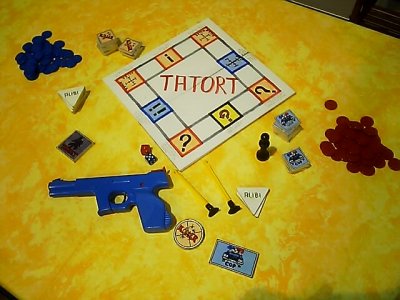 In Cop & Killer, each of the participating players is secretly dealt a marker qualifying him either as Cop, Killer or a bystander. In the first phase of the game these makers also may be secretly traded without the players knowing what they might get, but once everybody seems to be happy about their character the game starts on the board where a victim marker is moved around and a pawn of the Killer tries to catch it. The Police on the other hand tries to catch the Killer before he gets to the victim, and the Bystanders may either assist the Killer or the Police with hints so that they may get rewards from both sides. While moving on the gameboard, some spaces allow the players to get insights on other players' identities, and while one side of the gameboard favours steps taken by the police there is also a possibility that the gameboard needs to be switched over to a side which is more favourable for actions of the Killer. However, once either the Police catches up with the Killer or the Killer with his victim, the Dart Gun will be used for shooting at a target and if a hit is scored the shooting side with get a victory marker. The player's identities are revealed at the end of the game, and then a player having the highest combination of victory markers and money will have won the game. At the moment, GAMEHEADS are taking last steps for production of the game. They have found a very robust and well working type of Dart Gun (unlike the erratic Supergang Gun), but they actually try to secure a sufficient supply. The game is going to be released both in English and in German, and although their Homepage still is under construction it might be worthwhile to watch out for the game when it becomes available. 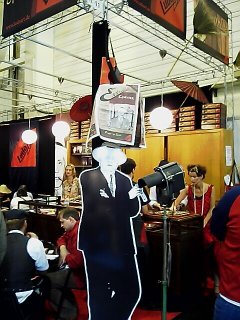 Talking about guns and Killers, I also had a look at an other game with a Gangster-based topic which stands in strong contrast to King of Chicago which I presented to you yesterday. Presented at an impressively atmospheric booth, LUDO ART did put up their new game Gangster for testing, a game with both its contents and its graphics being closed based on a book. The board of the game is square with an underlying map of Chicago, but it actually just features as a base for the printed on grid since the game is rather abstract by its nature. Defined by colour, each player represents one of the major Mafia Clans of Chicago, and each turn a player either puts a maker of a clan member on the gameboard or moves a marker on the board for one space horizontally or vertically. Each marker has a strength of one to three, and at the beginning of the game each player is equipped with one marker of each strength, but there are many more of his clan members available in the drawing pile. 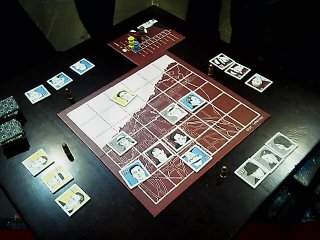 When taking his turn and playing a new marker, a player may choose either to take a marker from his own stock or take one from the common drawing stock (two markers of which are always revealed). Placing their markers, players try to complete either a horizontal or vertical row of markers on the board, and if a player puts the last marker into a row an evaluation takes place. Now each player with markers in the row adds up the total value of his markers, and the player with the highest total receives victory points equal to the value of his markers minus the value of the markers of the second-strongest player. If two players tie for first place, the third player will take advantage and receive the victory points for his total. As long as a row of markers has not been finished, markers also may be moved into neighbouring hexes, possibly getting them into a better position for a higher scoring. However, this action becomes impossible as soon as a row was finished, and this the gameboard becomes more and more final. As a special twist, there are some "real" bullets included in the game which the players may use to "shoot" another player's marker. This marker remains on the gameboard but becomes inactive and thus his strength is not included in any kind of evaluation. As you can see, the game is rather abstract but due to its very premium playing components and graphical design it still offers an atmospheric density which many other games lack. Its purely strategic playing mechanism is only to a very small portion influenced by luck when turning around new markers, but despite its orientation as a "brain-teaser" the game actually is rather fun to play. And a good, short strategy game with a high entertainment value and a fitting background concept certainly is something I do not see too often! 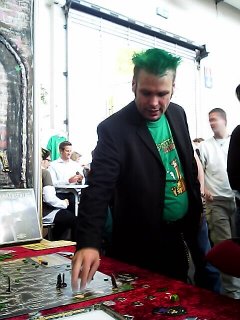 Saving something good for the last, I went up to the booth of 2F SPIELE where Friedemann Friese was happy enough to give a presentation of his newest creation... It has been a while since a band of daring adventurers has embarked on their long quest to save Fairy Fabula who has been captured by sinister Fürst Fieso. However, after fighting their way out of Fieso's clutches in Finstere Flure, our Heroes now have entered Fieso's final Dungeon to free Fabula. However, there are Fürchterliche Feinde waiting everywhere, so the Heroes have to be careful indeed. At the beginning of the game the gameboard showing Fieso's dungeon is spread out, and a green Power chip is placed within every room of the dungeon. The rooms are interconnected by passages and crossroads, and at each of these crossroads a face-down crossroads marker is placed. During the game, these crossroad markers will be revealed, and usually they will not be open to all sides so that passages will be blocked and players will have a changed Dungeon layout every time they play. Four special teleport markers are also placed at certain positions, and during the game these teleporters are interconnected in pairs, so that a player may move from one teleporter to the other. The 50 monster tokens available in the game actually are not mixed but sorted after their strength. The upmost four monsters with a strength from 1 to 4 are mixed and placed in the four entrance rooms of the Dungeon. The following monsters with strengths from 5 to 48 then are placed in a stack in rising order, and only the last two monsters (Fieso and his monster Furunkulus) are mixed up with three additional treasure tokens and placed below the ordered stack of monsters. Each player receives a token to mark his current wisdom on the wisdom-track of the board (start player starts with one wisdom, next with two wisdom etc) and a stockpile of six power chips, and finally the spell cards available are sorted into four decks which are mixed thoroughly. During a player's turn, a player has the options to either move and fight, move twice or take additional power chips from the power track. If a player moves, he may move up to six steps within the dungeon, but he has to stop on a room occupied by a monster. There he has to stay until the monster is defeated, unless the monster still is too strong for him in which case he may flee the following turn. If a player arrives at a room with a monster and decides to battle it, the outcome of the battle is determined by a player's current wisdom. If a player's wisdom is equal or greater than the strength of the monster, he may battle it and a battle dice has to be rolled both for the Hero and the monster. The result of the combat is reached by substracting the dice roll of the player from the monster's dice roll (the monster's dice shows slightly higher results), and the fighting player has to give up the resulting number of power chips. However, if the player was lucky and a negative result is the outcome of the battle, he has to pay no power chips but receives an additional Gold as a bonus. If the player can pay the demanded result of power chips, he has won the battle and will receive its token. This token has a value of one to seven Gold, and in the end the winner of the game will be determined by each player adding up their Gold stockpile. In addition, the player also may draw to upmost card from the deck of spells and furthermore he will gain wisdom, allowing him to adjust his wisdom so that it now matches the sum of the monster's strength plus a wisdom award which depends on the number of participating players. Seeing this combat mechanism, it becomes clear that a player will gain no new wisdom from fighting weaker monsters, and such monsters accordingly are so awed by the attacking player's wisdom that they die from a heartstroke. Also, a player who wins simply by an exceedingly high wisdom will only receive a lower reward for the killed monster, thus reducing the monster's gold value by one. If, on the other hand, a player's wisdom is lower than the monster's strength he may still combat against it, and even though he cannot win he will get an additional wisdom as a reward for trying. After a successful combat, all power chips still allocated in rooms connected to the newly cleared room are removed and exchanged for new monsters from the sorted pile, so that the player now will see which monsters wait in the rooms to come. Also, now the time has come to reveal the crossroad markers in adjoining corridors, and here a player has to turn them over one edge without changing their facing. All power chips taken from the gameboard are placed on the power supply scale on the gameboard, and here also one power chip is placed of the quota of chips which a player has to pay for winning a battle. If a player decides not to move, he may instead take approximately one third of the power chips from this power supply scale, thus refreshing his character's power supply for the battles to come. So far, so good. But you might actually ask what specific rules are included in the game which Friedemann Friese considers to make the game a worthy successor to both Fische, Fluppen, Frikadellen and Finstere Flure. For one, the game also contains the already mentioned spells, and the variety of spells included allows a player to move farther, increase his supply of power chips or wisdom for a battle, turn crossroads or to influence a monster by either increasing or decreasing its strength or moving it for a room or two. Okay, spells are not new to fantasy games either, but when you consider the fact that the game does not work on an engine of randomly drawn monsters but a sorted deck of monsters you discover that the game features and element of strategy other "Dungeon Crawl" type games lack. Here you may calculate which monsters appear next, and by the clever use of spells you can either hamper your opponents or manipulate the outcome of a combat of your own character in a way to either win against a strong monster or to have a higher wisdom increase from a weaker monster. Another special rule also is connected to the movement of monsters. After the first 23 monsters have been used, a token for the most dim-witted adventurer will be introduced, and this token always stays with the player having the lowest wisdom rating. That player now becomes enabled to move the weakest monster on the board for up to three rooms, and moving the monster around opens the player a lot of different possibilities since he now may either pick up other character and move them to rooms with stronger monsters, pick up his own character to move him for a greater distance in the dungeon, or just move the monster to his character to be able to fight it and gain additional wisdom. A further rule actually quite nicely captures the spirit of fantasy games, since a player also may decide both to follow a player with more wisdom as some sort of apprentice. When sharing a space with a more wise player, the wiser player may be followed by the apprentice whenever he moves, and for each turn the apprentice spends with the wiser player he will get one wisdom for himself. However, this only works as long as the apprentice has less wisdom than the other player, and this procedure also does not allow to raise wisdom so far as to become level with the wisdom of the master. Unfortunately, a player may not refuse an apprentice, but if he possesses a fitting invisibility spell he may leave the apprentive without giving him a chance to follow. Once the last two monsters Fürst Fieso and Furunkulus have been killed, the game directly comes to its end. However, since even a Fairy like Fabula has an economic spirit and some demands for luxury, she will - rather materialistically - choose the richest player as the winner of the game. 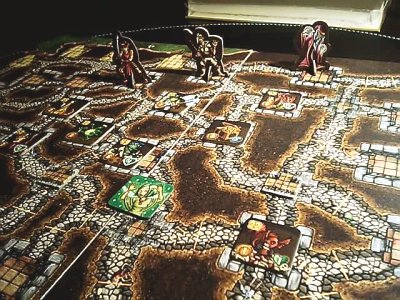 Friedemann Friese's gaming trilogy about Fieso and Fabula started with Fische, Fluppen, Frikadellen as an economy-tactics game, was then followed by a clever Roborally spin-off in Finstere Flure and now has become a Dungeon exploration game with Fürchterliche Feinde. As said, the real strength and novelty about Fürchterliche Feinde is the fact that the appearance of each monster may be calculated and thus the game offers much more room for strategy than you would expect from a usual Dungeon game. Only the ending is kept open, since the last five markers in the monster deck are a random shuffle of Fieso, Furunkulus and three treasure chests, and here a tight game may find an exciting ending due to some last minute changes in the players' gold scores. Although not equipped with a mind-boggling monster-movement-mechanism like Finstere Flure, this new game of Friedemann Friese once again is refreshingly different from many things which have been tried in former games, and this coupled with the also included good degree of player interaction which is especially caused by the "dumbest player" rules gives the game a remarkable atmosphere which might not be guessed by a first fugitive look on either box or board. But as all things come to its end, I now also have reached the final paragraph for my reporting of the SPIEL 06. To give a summarized view of the convention, I would say that the overall quality of available games has increased this year if you make a comparison to 2005. Once again, quite a lot of smaller and major publishers alike have come to Essen with rather nice and entertaining games, and especially the smaller publishers have shown how much they have catched up in terms of professional design with the long-standing publishers. However, this year I was also quite hard pushed to nominate a game for… Kulkmann's Convention Hit ! A heavyweight coming evergreen like the new Battlelore which actually is not just a boardgame but also a whole gaming system which keeps all the advantages of a boardgame would be a suitable winner here, but I usually want to give this award to one of the smaller publishers since these usually do not receive the publicity they deserve and Battlelore is going to get rewards from much more distinguished places than just my G@mebox.  Thus, I decided to put my special recommendation out for King of Chicago, a game which certainly does not receive unanimous praise from many other reviewers around. However, those of you who have followed my G@mebox reviews over the years will not only have recognized my strong demands of a game to have a good background story which is well reflected by the rules, but you will also have discovered my Talisman-Section and my great passion and vice for dice-rolling adventure games. King of Chicago definitely is more than a simple dice-roller, but despite its orientation on building up a "criminal economy" the game somehow also gives a great feeling of adventure which goes behind simple economic planning: small jobs to solve, shootouts to survive and a "loyal" gang of personalized henchmen leave a feeling of involvement which you usually find in adventure games, and here King of Chicago to my mind has fully succeeded in making a clever combination of both. Perhaps the rules could need a twist or two concerning the sometimes rather unbalanced drawing of cards in the evaluation phase, but I still consider King of Chicago to be a game with a high replay value and a dangerous addictive potential !!! 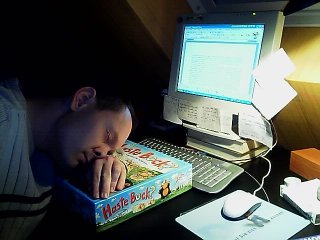 And now, at 01:20 AM Essen time on Monday, 23rd of October 2006, seven hours and 20 minutes after the closing of the SPIEL 06, I am going to get some hopefully well-deserved sleep! ;-) Thanks for bearing with me during the Convention, and I hope to meet everybody back here next year! This was Essen, signing off ! Frank Schulte-Kulkmann PRIZE DRAW!
To win the new promotional figures of the Earth Elemental and the Hill Giant for the new DAYS OF WONDER game Battlelore or the Settlers Expansion, all you have to do is to sign the SPIEL Guestbook ! Prize Draw Winners !!!!!Battle Lore Hill Giant Gerard Hokke Adrian Lee Battle Lore Earth Elemental Jeff Paul Scott Woodard The Settlers 'Great Caravan' Expansion Shawn Low
If you want to have a peek at my coverage of previous conventions, follow these links:
Opening timesFrom thursday to saturday the convention is opened from 10 AM until 7 PM, on sunday from 10 AM to 6 PM. Travelling to the Messe EssenIf you arrive at Düsseldorf International Airport, it takes about 20 minutes to get to the Messe Essen by Cab. If you hire a car at Düsseldorf Airport, you go onto Autobahn A44 (blue signs), and at the next motorway crossing you go over to A52, direction Essen. Take Exit "Essen Rüttenscheid". You can also go by train to Essen Central Station. If arriving there, go to the basement and take the Subway U11 directly to the Messe Essen. If you want to arrange lodging at Essen, you best contact the Essen-tourism-center by phone 0049/(0)201/19433 or 0049/(0)201/88720-46 or -48. Perhaps they know where some Hotel-rooms are left... |
|
| |

Looking for the new games? Visit Funagain Games! |
|
|
| |
|
Kulkmann@aol.com
Copyright © 2006 Frank Schulte-Kulkmann, Essen, Germany | |